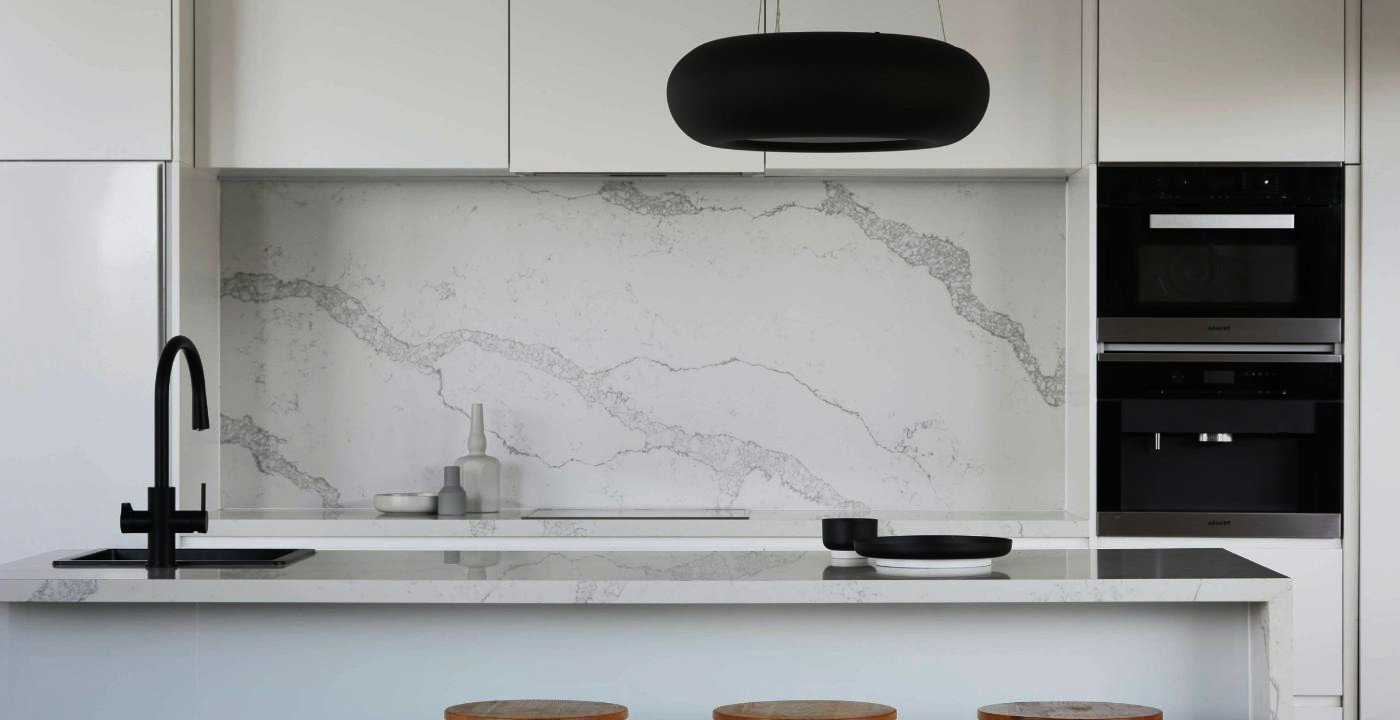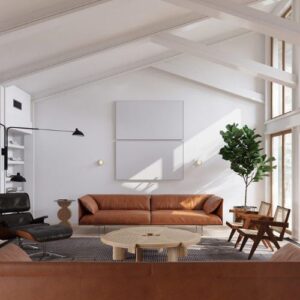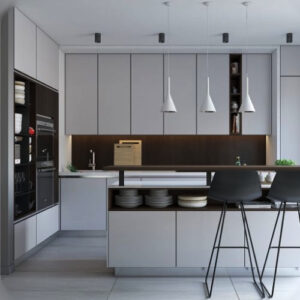Key Summary
- Declutter and simplify your kitchen space for a clean and organized minimalist kitchen design.
- Opt for a neutral color scheme with pops of color for visual interest.
- Maximize natural light and incorporate thoughtful artificial lighting.
- Utilize efficient storage solutions and consider open shelving for display.
- Choose sleek materials and textures to add depth and contrast to your kitchen.
How to Choose the Best Minimalist Kitchen Design for You
When it comes to choosing the best minimalist kitchen design for your home, there are a few factors to consider to ensure it works well for you.
Personal Style
First and foremost, think about your personal style and preferences. Minimalism can encompass various aesthetics, from sleek and contemporary to rustic and natural. Determine the overall vibe you want to create in your kitchen and choose design elements accordingly.
Kitchen Size and Layout
Consider the size and layout of your kitchen space, for example, if your kitchen is on the smaller side then you might want to focus on maximizing storage with space-saving solutions such as pull-out drawers. On the other hand, if you have a larger kitchen, you have more freedom to incorporate additional design elements, such as an island or a dining area.
Practical Needs
Think about the practical aspects of your kitchen too. Consider your cooking habits, storage needs, and lifestyle. If you love to cook and entertain, prioritize a spacious and well-equipped kitchen with ample countertop space and a functional layout. If you have a minimalistic approach to cooking and prefer simplicity, opt for a more streamlined design with minimal ornamentation.
Other crucial elements of your minimal kitchen design that you will want to get right include the color scheme as well as materials and texture. We talk further about these elements throughout the article but they play a big role in adding personality and interest to your space, and should be forgotten about!
Source Ideas
Lastly, seek inspiration and gather minimalist kitchen ideas from various sources such as design magazines, websites, and social media platforms. Pay attention to different styles, layouts, and color schemes that resonate with you and then create a mood board with any images you find that capture your ideal space.
1. Decluttering and Simplifying
The first step towards a minimalist kitchen is decluttering. Channel your inner Marie Kondo and remove all unnecessary items from countertops, cabinets, and drawers. Embrace the mantra “less is more” by organizing your kitchen essentials and eliminating duplicates or items you rarely use. Consider donating or storing items that do not serve a practical purpose in your daily routine.
Streamline your storage solutions by opting for sleek and minimalistic cabinets and drawers. Choose designs with clean lines, hidden handles, and ample storage space to keep your kitchen clutter-free and visually appealing. Utilize vertical storage options to maximize space, such as open shelves or hanging racks for frequently used utensils and cookware.
Pros:
- Clean
- Organized
- Visually appealing
Cons:
- Potential difficulty letting go of belongings

Source: Pinterest
2. Color Scheme
When it comes to the color scheme in a minimalist kitchen, opt for a neutral palette to create a sense of calm and simplicity. Shades of white, beige, gray, and muted pastels work well in achieving a minimalist aesthetic in your kitchen as these colors provide a timeless backdrop that allows other elements to shine, while still maintaining a cohesive and serene atmosphere.
To add interest and visual impact to your minimal kitchen, incorporate pops of color through accessories or a single accent wall. Consider vibrant kitchen utensils, artwork, or a colorful but minimalist backsplash to create focal points and break the monotony of neutral tones.
Pros:
- Calming
- Cohesive
- Timeless
Cons:
- Limited color expression
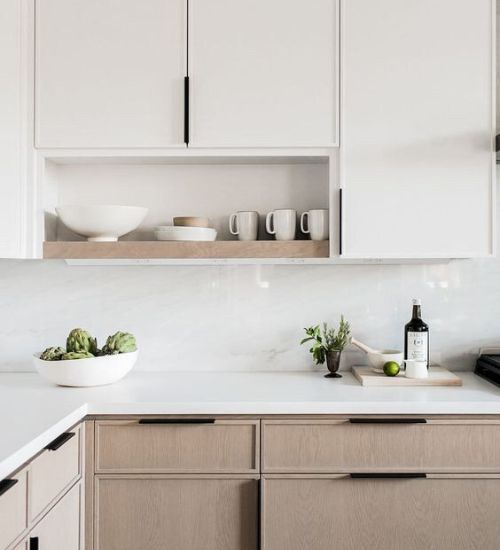
Source: Pinterest
3. Lighting
Maximize natural light in your minimalist kitchen to create an airy and inviting space. Remove heavy curtains or blinds and opt for sheer or translucent window coverings that allow light to filter through. If possible, you could install skylights or larger windows to flood the space with natural sunlight.
In addition to natural light, incorporate a layered approach to artificial lighting. Use recessed or track lighting for overall illumination, pendant lights or chandeliers for task lighting, and under-cabinet lighting to highlight specific areas. Adjustable dimmers will provide flexibility and allow you to set the desired ambiance.
Pros:
- Bright
- Inviting
- Versatile
Cons:
- Can be challenging to generate more natural light if it doesn’t exist already
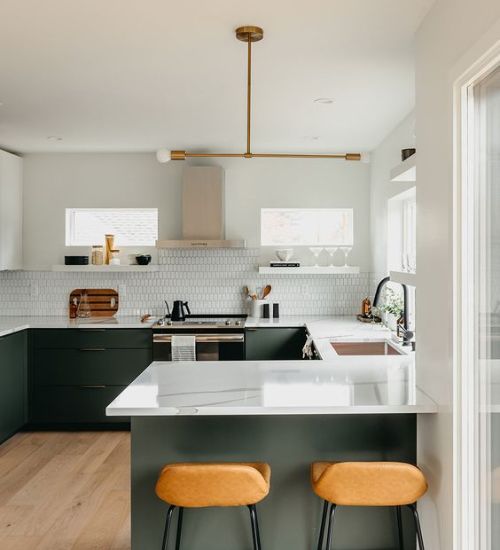
Source: Pinterest
4. Storage
In a minimalist kitchen, well-organized storage is crucial. Invest in cabinets with smart interior fittings, such as pull-out drawers, dividers, and adjustable shelves as this will help you maximize every inch of space and ensure that everything has its designated place. Consider utilizing hidden storage solutions like toe-kick drawers or ceiling-height cabinets for seldom-used items.
Open shelves are an excellent option to display your most-used kitchenware while maintaining an organized and minimalist look. Use them to showcase stylish dinnerware, glassware, or cookbooks. Remember to keep the shelves tidy and avoid overcrowding to maintain the clean aesthetic.
Pros:
- Efficient
- Organized
- Functional
Cons:
- Limited display options

Source: Pinterest
5. Materials and Textures
Choose materials that embody simplicity and minimalism. Opt for smooth, sleek surfaces like quartz or solid-surface countertops, which provide a clean and contemporary look. Consider using materials such as stainless steel or matte-finish metals for appliances to complement the overall minimalist aesthetic.
Introduce texture and contrast to add depth and visual interest to your minimalist kitchen and make use of materials such as natural wood or stone for countertops, backsplashes, and flooring to create a warm and inviting atmosphere. The juxtaposition of smooth surfaces with textured elements can create a striking visual impact that supports your aesthetic.
Pros:
- Sleek
- Varied
- Visually interesting
Cons:
- Potential maintenance requirements
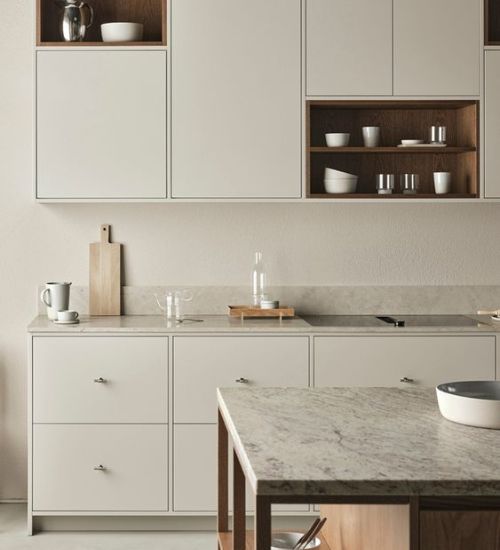
Source: Pinterest
6. Countertops and Backsplash
Minimalist kitchens often feature clean and uncluttered countertops. Choose a durable and low-maintenance material for your countertops, such as quartz or solid-surface options. Avoid excessive ornamentation or intricate patterns that may disrupt the minimalist aesthetic.
Select a backsplash that complements the overall design of your kitchen, using a minimalistic tile or single slab of material for a seamless but cohesive look. Neutral colors or monochromatic patterns work well to maintain the clean and understated style of a minimalist kitchen.
Pros:
- Clean
- Durable
- Low-maintenance
Cons:
- Lack of design options
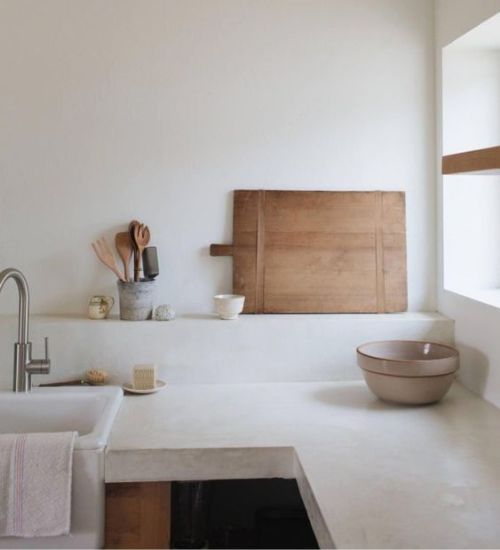
Source: Pinterest
7. Appliances
To maintain a streamlined appearance in your minimalist kitchen, consider integrating appliances into your cabinetry. Built-in refrigerators, dishwashers, and microwaves can blend seamlessly with the surrounding cabinetry, creating a cohesive and uncluttered look whilst concealed range hoods can also contribute to a minimalist aesthetic.
In a minimalist kitchen, functionality takes precedence over excessive features or complex designs. Choose appliances that align with your cooking needs and prioritize ease of use and efficiency. Opting for sleek and modern minimalist kitchen designs will complement the overall style
Pros:
- Streamlined
- Integrated
- Efficient
Cons:
- Can be more expensive
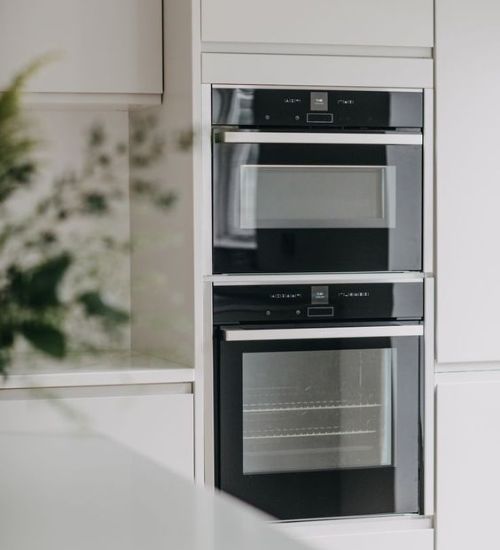
Source: Pinterest
8. Minimalist Kitchen Decor
When adding decor elements to your minimalist kitchen, adhere to the principle of simplicity. Select a few carefully-curated pieces that enhance the overall aesthetic without overwhelming the space. Choose minimalist artwork, potted plants, or tasteful decorative objects that contribute to the serene ambiance of the kitchen.
Pros:
- Simple
- Tasteful
- Enhances ambiance
Cons:
- Lacks personality
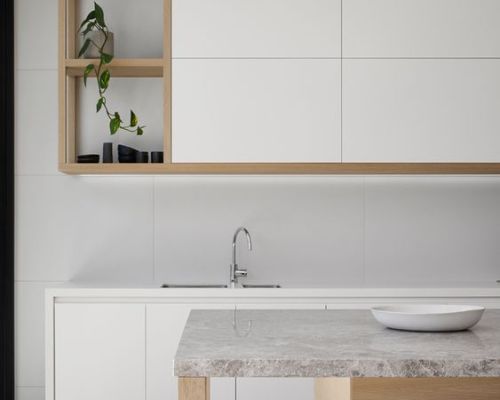
Source: Pinterest
9. Embrace Negative Space
Negative space, also known as empty space, is a key element of minimalist design. Allow areas of your kitchen to breathe by leaving open spaces on countertops, walls, and shelves. Embracing negative space creates a sense of calm and visual balance, enhancing the overall minimalist feel of the kitchen.
Pros:
- Calm
- Balanced
- Visually pleasing
Cons:
- Can make the space feel too bare

Source: Pinterest
10. Streamlined Furniture and Seating
If your kitchen allows for additional seating or a dining area, opt for streamlined furniture that aligns with the minimalist style. Choose chairs or stools, in materials such as wood, metal, or plastic, with clean lines and minimalistic designs that blend seamlessly into the overall aesthetic.
Pros:
- Sleek
- Cohesive
- Minimalist aesthetic
Cons:
- Minimalist materials aren’t known for comfort
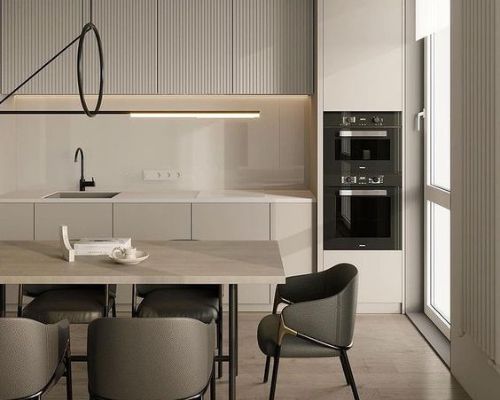
Source: Pinterest
11. Greenery and Natural Elements
Introduce greenery and natural elements into your minimalist kitchen to bring a touch of nature indoors. Add potted plants, herbs, or succulents to create a fresh and vibrant atmosphere and incorporate natural materials like wooden cutting boards, bamboo utensils, or stone countertops to enhance the organic feel.
Pros:
- Brings nature indoors
- Adds freshness and vibrancy
Cons:
- Requires maintenance
- Potential clutter if not well-organized
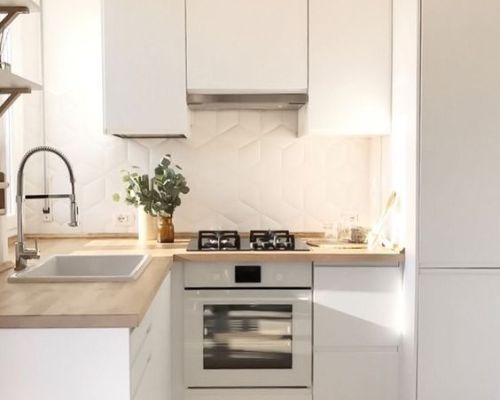
Source: Pinterest
What to Avoid in a Minimalist Kitchen
While creating a minimalist kitchen, it’s important to be mindful of certain design choices that may undermine the overall aesthetic and functionality. These include:
Avoid Excessive Decoration
Avoiding excessive ornamentation and decorative elements that detract from the simplicity of the space. Minimalist kitchens thrive on clean lines and a streamlined look, so refrain from incorporating unnecessary embellishments or intricate patterns that may create visual clutter.
Avoid Excessive Colors
Steer clear of excessive colors that disrupt the cohesive and calming atmosphere of a minimalist kitchen. While pops of color can be introduced strategically, using too many vibrant hues or conflicting shades can create a chaotic and overwhelming visual impact. Stick to a carefully chosen color palette that promotes a sense of tranquility and harmony.
Don’t Overcrowd Countertops
Avoid overcrowding countertops and open shelves with unnecessary items. Keep only the essential items on display and store the rest out of sight. This will help maintain a clean and uncluttered look, allowing the design elements of your kitchen to shine.
Don’t Compromise
Do not compromise on functionality. While aesthetics are important, a minimalist kitchen should not sacrifice practicality. Ensure that your kitchen design prioritizes ease of use, efficiency, and accessibility.
Select Durable Materials
Avoid choosing materials that require excessive maintenance or are prone to wear and tear. Select durable and low-maintenance materials for countertops, flooring, and backsplashes. This will not only contribute to the longevity of your kitchen but also minimize the need for frequent upkeep and repairs.
Utilize Proper Organization
Avoid overlooking the importance of proper organization and storage. In a minimalist kitchen, storage solutions play a crucial role in maintaining a clutter-free environment. Avoid neglecting this aspect and invest in functional cabinets, drawers, and organizational tools that optimize space and keep everything in order.
Conclusion
Achieving a stunning minimalist kitchen design requires careful consideration of various elements, from decluttering and simplifying to selecting the right color scheme. Remember, the key to successful minimalist kitchen design lies in embracing simplicity, eliminating unnecessary clutter, and choosing sleek, streamlined elements. By implementing these strategies, you can transform your kitchen into a modern and inviting space that reflects your minimalist lifestyle.

